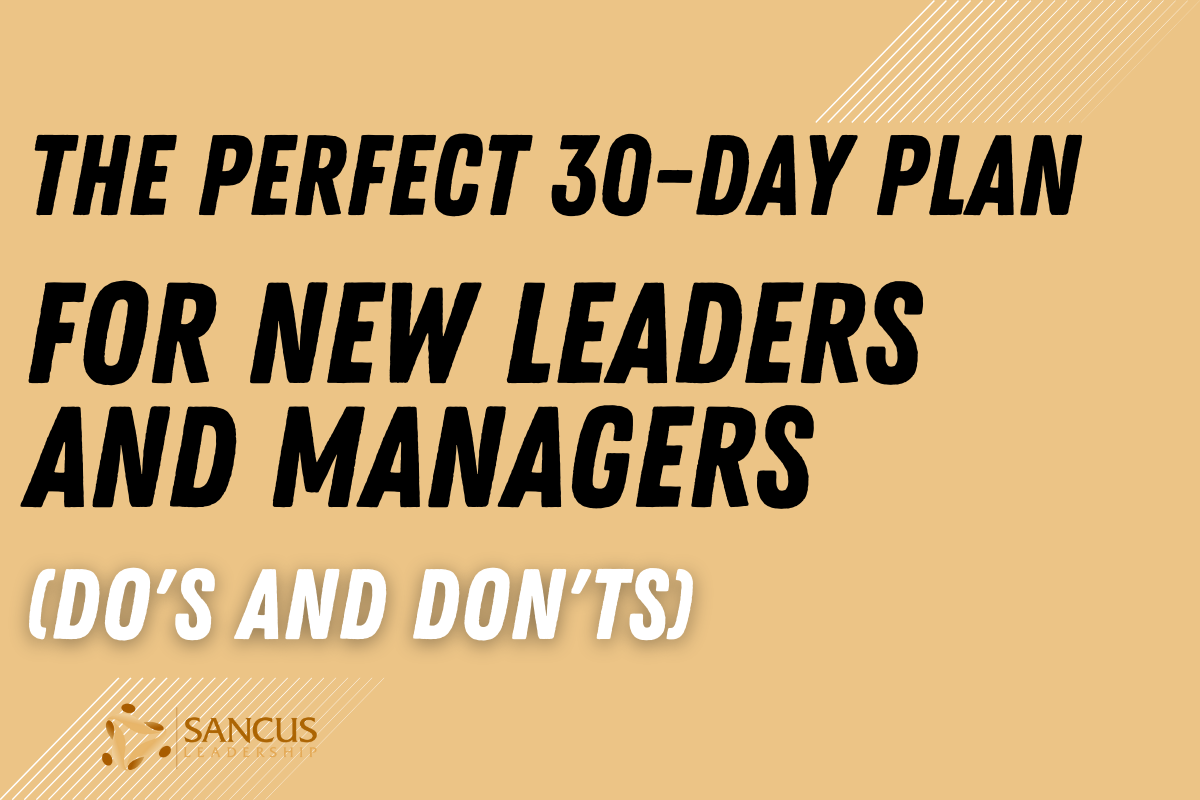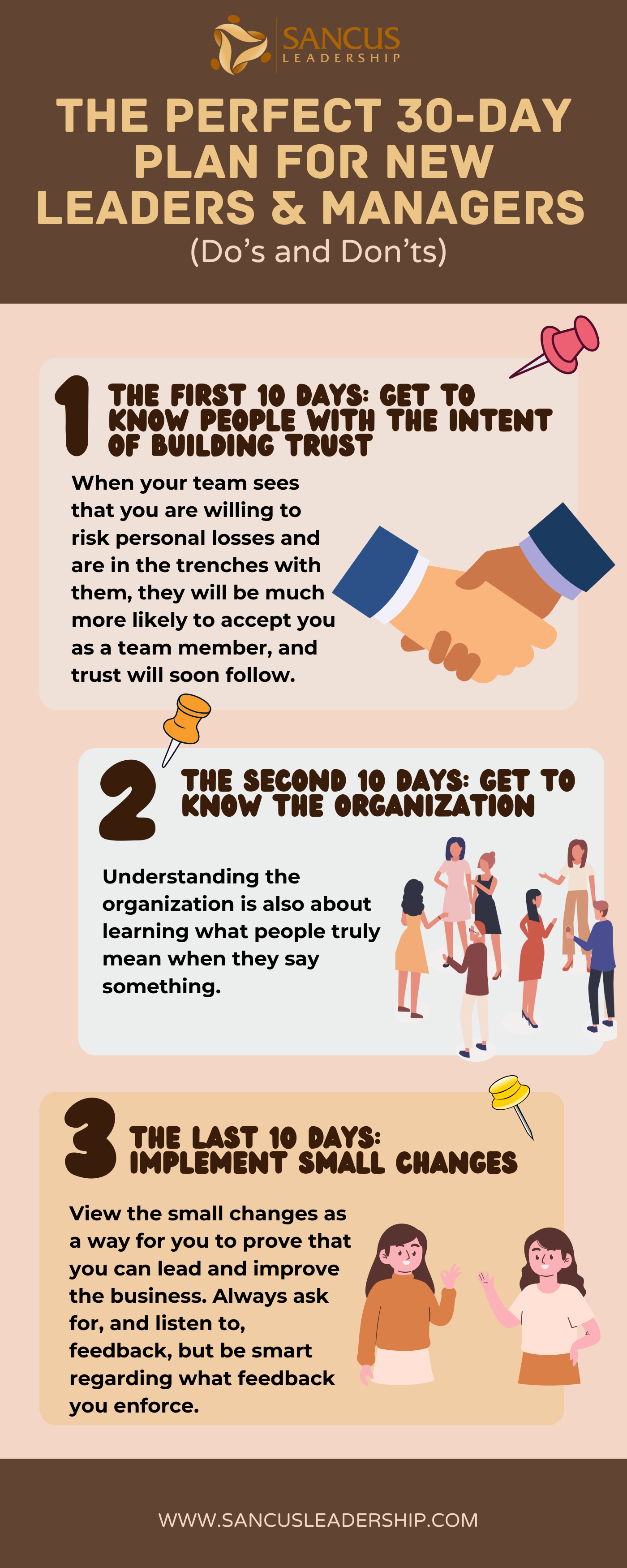Your cart is currently empty!

The Perfect 30-day Plan For New Leaders & Managers (Do’s and Don’ts)
We performed a study (Sancus Leadership) and interviewed experienced small team leaders about the biggest mistake you can make during your first 30 days as a new manager. The consensus is that concentrating too much effort on logistics and practicalities and disturbing the order is worse than any other action you can take.
The perfect 30-day plan for new leaders and managers includes implementing minimal changes and low-value tasks, such as organizing their workplace perfectly. New managers must also focus on getting to know their colleagues and understanding the organization.
Stick around if you want to know what other small team leaders and managers did when they first started. This article discusses the perfect 30-day plan you’ll want to follow when you begin a new leadership role.
What New Leaders and Managers Get Wrong

You need to understand the importance of relationships and the organization to avoid finding yourself where building trust with your team takes much more time than you have.
Remember, you can’t effectively implement significant changes until you’ve proven to your team that they can trust your judgment. They also need to know that you are working in the best interest of your team and the business.
Mellinger defined trust as an “individual’s confidence in another person’s intentions and motives and the sincerity of that person’s word.“
The definition is interestingly specific. To trust someone, we need to know they are telling the truth and their intentions are known, but it doesn’t mean we have to agree with the purposes.
So what do other managers and leaders say are the most important things to do when starting a new role?
Survey Results
Our survey prompted some exciting results about what is essential during the first 30 days of being in a management position.
Here’s what the participants said:
- Implementing change is the least important. (70%)
- Understanding the organization is the most important. (50%)
- Social relationships are the most important. (40%)
- Understanding both organizational and social relationships is the most important. (75%)
This leads us to the first and most crucial step of your 30-day plan as a new leader or manager. And if you need help getting established, contact me for a free leadership development session.
The First 10 Days: Get To Know People With The Intent Of Building Trust

“I think ensuring you’ve spoken to all employees is extremely important. Start building relationships with everyone and make everyone understand they can turn to you for feedback.”
Most people think that trust is built through team-building exercises or just spending time together, and it’s something that merely happens. But, since you’re here reading this article, I’m willing to bet you have the experience to tell you otherwise.
We have many people in our lives that we have spent much time with that we don’t trust. Can you think of a few in your life?
Most of us have also been to those team-building events and cringed our way through some weird “teamwork activity” with ropes and quizzes that are supposed to build “trust and resilience in teams.”
This doesn’t work because we start trusting people when they choose to do something in our favor, even though it negatively impacts their situation. For us to trust someone, they must have “skin in the game,” something to lose, but still, choose to go through.
For example, the leader of a nation who chooses to go to war even though they know their sons and daughters will be on the frontline is much more worthy of our trust than someone who has nothing to lose from their decisions.
A Better Way to Build Trust
Whether you call it earning or building trust, there’s a much better way than with old-school team-building activities.
As a new leader, you must put yourself in situations where you have something to lose from your decisions and do what is right for the team and the organization. One example is putting assets on the line, like your time or reputation.
It would be best if you acted in a risky but not foolish manner, and having skin in the game puts your awareness on alert and forces you to be smart about choosing a direction for your team.
It would be best if you acted in a risky but not foolish manner, and having skin in the game puts your awareness on alert and forces you to be smart about choosing a direction for your team.
When your team sees that you are willing to risk personal losses and are in the trenches with them, they will be much more likely to accept you as a team member, and trust will soon follow.
The Second 10 Days: Get To Know The Organization

“Continue to learn routines, participate in meetings and processes to learn culture and language.”
In our study, half of the respondents said that understanding the organization is the highest priority these first 30 days as a manager. However, understanding the organization is more than just knowing what products are produced, where the office is, and what the official vision is.
If this is your approach, you’ll likely misunderstand the driving force behind its success. Often, companies have beautiful visions and missions written on some fancy walls, but when you look close enough, you’ll see there is something far more profound than that.
In military teams, we often talk about doing good and helping people out, but we all know that when bullets start flying and things get incredibly intense, all of that goes out the window. The only thing that matters right here, right now, is the person next to you, the friend, the colleague, the warfighter.
Business is the same. When times are tough, and tasks are boring and mundane, most people show up to work because they value who they’re working with. They might even hate their boss, but hopefully, this won’t happen to you.
But they show up and get things done because they know their colleagues will do the same. In this example, the real purpose or driving force isn’t some fancy meme on a wall but the trust and family spirit built into the organization’s fabric.
Understanding the organization is also about learning what people truly mean when they say something. In the military, this is easy, as the most important words have already been given a specific definition. For example, “fire” always means to shoot and never to “make a fire.”
Look at the type of definitions your organization uses. You’ll likely find some unique words that don’t make much sense to you, so be curious and see what they truly mean.
Look at the type of definitions your organization uses. You’ll likely find some unique words that don’t make much sense to you, so be curious and see what they truly mean.
You can better understand the organization by doing the following:
- Read official policies.
- Read informal discussions, such as on Slack channels.
- Participate in meetings outside of your area of responsibility.
- Look for language that has an implicit meaning.
| You can better understand the organization by doing the following | Description |
| Read official policies. | To gain a comprehensive understanding of an organization, it is crucial to familiarize yourself with its official policies. |
| Read informal discussions, such as on Slack channels. | In addition to official policies, informal discussions can provide valuable insights into the organization’s culture and dynamics. |
| Participate in meetings outside of your area of responsibility. | Attending meetings beyond your specific responsibilities can broaden your perspective on the organization. |
| Look for language that has an implicit meaning. | Pay attention to the language used within the organization, as it often carries implicit meanings. |
The Last 10 Days: Implement Small Changes

Although almost all of our respondents said that the worst thing you can do as a manager during your first 30 days as a leader is implement big changes, you still need to start doing your job.
By the end of the day, you are the new manager in charge of keeping things running. Implementing significant changes will likely be criticized brutally, especially if you have nothing to lose. However, your team has something to lose, which usually only works sometimes.
A much better way is to start small, or as one respondent said:
“Another important thing is to create structures (meetings, information emails, etc.) so that those involved in the business know what they can expect from you.“
These are some great examples of where you can start to change things up and do the things you believe will benefit the organization without relying too much on the trust of your team to make it happen.
View the small changes as a way for you to prove that you can lead and improve the business. Always ask for, and listen to, feedback, but be smart regarding what feedback you enforce. And if you need help, a free leadership session might be needed.
View the small changes as a way for you to prove that you can lead and improve the business. Always ask for, and listen to, feedback, but be smart regarding what feedback you enforce.

If you’re a new manager, here is a helpful video sharing practical tips to help you organize and be successful during your first 30 days.
Conclusion
When you start a new role in a leadership position, you don’t want to focus on inconsequential matters. Getting to know your team and what they want or need while doing their job can go a long way to helping you get established.
